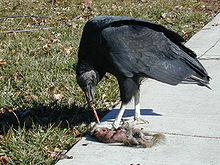Carrion

Carrion refers to the carcass of a dead animal. Carrion is an important food source for large carnivores and omnivores in most ecosystems. Examples of carrion eaters, or scavengers, include hyenas, vultures, Tasmanian Devils, Bald Eagles, and Blue-tongued lizards. Many invertebrates, such as worms and carrion beetles (family Silphidae) also eat carrion and play an important role in recycling animal remains.
Carrion begins to decay the moment of the animal's death, and it will increasingly attract insects and breed bacteria. Not long after the animal has died, its body will begin to smell of a foul odor, caused by the presence of bacteria. Some plants and fungi fake the scent of decomposing carrion to attract insects to aid in reproduction. Plants that exhibit this adaptation are known as carrion flowers. Stinkhorn mushrooms are examples of fungi with this characteristic.
Carrion is also a breeding ground for disease. It is recommended that one use proper gloves (such as rubber) to handle it, and wash one's hands thoroughly afterward.
